Royal Australian Navy
-
- Todd Seattle Division Lays Keel For Royal Australian Navy Frigate Maritime Reporter, Sep 1977 #18
Significant events occurred with keel-laying for the HMAS Adelaide at Todd Shipyards Corporation, Seattle Division, on July 29.
This will be the first of two guided missile frigates (FFG-7 Class) which are being built especially for the Royal Australian Navy.
On hand for the ceremony were guests from the City of Adelaide, along with Rear Adm. J.D. Murray, Commandant of the 13th Naval District.
Ward E. Squires, Seattle Division FFG Project Manager, noted that the HMAS Adelaide will be the first delivery of a combat vessel by the Division to a foreign government since before the First World War.
Principal c h a r a c t e r i s t i c s of these multipurpose ships include: length, 445 feet; beam, 45 feet; displacement, 3,600 tons; horsepower, 40,000 and speed, 28 knots.
Nineteen of the FFG's have been contracted for by the Navy. Options for additional vessels, which have both guns and missiles as armament, are expected to be exercised in the next fiscal year.
The HMAS Adelaide is named after the capital city of the Australian State of South Australia.
This follows the precedent established of naming major Commonwealth naval units after capital cities. Adelaide also was the name of a previous Australian lightcruiser which saw action during World War II and left service in 1949.
The principal guest and speaker for the ceremony was Commodore R. Geoffrey Loosli, Naval Attache f r om the Australian Embassy in Washington, D.C. He explained the significance of this event: "It has been nearly 12 years since Australia has had a keel laid for a destroyer-size naval vessel." Commodore Loosli emphasized the close ties between the United States and Australian Navies, which go back to World War II. He stated: "Australia looks forward to association with Seattle, both from the standpoint of construction at Todd and housing the Australian crew and their families in the local area." The two Australian ships with a value of one hundred million dollars will be an asset to the general Seattle economy. The Division is upgrading and expanding its facilities to meet the challenge of this new construction program. Workforce at Todd's Seattle Division may grow from the present 1,300 employees to over 3,000 before the FFG Program is completed.
-
- For the Royal Australian Navy, Technological Leap Starts Small Marine Technology, May 2020 #18
Driven by the need to organically protect maritime Task Groups from the threat of sea mines, the Royal Australian Navy is introducing a deployable Mine Counter-Measures (MCM) capability under the first phase of Project SEA 1778.The Royal Australian Navy’s (RAN) SEA 1778 deployable Mine Counter-Measures
-
- Todd Signs Agreement With Australian Shipbuilder For Technology Transfer Maritime Reporter, Dec 1986 #7
destroyer escorts, frigates, and submarines in Western Australia. Todd Pacific delivered the last of four guided-missile frigates to the Royal Australian Navy in 1983, and has contracted to assist the Australian Government in building two more of these FFGs in Melbourne
-
- Australia Receives First Of Four Gas-Turbine-Powered FFGs From Todd Seattle Maritime Reporter, Jan 15, 1981 #10
was commissioned into active service in formal ceremonies November 15 at Todd's facilities on Harbor Island, where Comdr. G.R. Lamperd of the Royal Australian Navy (RAN) of Canberra was given HMAS Adelaide's command. The Lord Mavor of Adelaide, the Right Honorable J.V.S. Bowen, was guest of honor
-
- Navy Contracts Totaling $203 Million Awarded To Todd Shipyards- Backlog Is $1.5 Billion Maritime Reporter, May 15, 1980 #16
or in the construction process. Of the total of 25 ships awarded to Todd thus far, 21 are for the U.S. Navy and four are f o r the Royal Australian Navy. One of the ships of the current order will be built at the Los Angeles Division and two at the Seattle Division. Mr. Gilbride stated
-
- Navantia Banks on the Future Maritime Reporter, Aug 2014 #89
decade, it has built 10 frigates for the Spanish Navy and Royal Norwegian Navy and currently is providing design and technical assistance to the Royal Australian Navy for the construction of 3 AWD destroyers. • LHD ships: It has built one unit for the Spanish Navy, two units for the Royal Australian Navy
-
- Australian Admiral Test-Starts New Sub Engine At Hedemora Diesel—Literature Available Maritime Reporter, Dec 1989 #48
Rear Adm. Oscar Hughes, project leader with overall responsibility for the Royal Australian Navy's new submarine project, recently visited Sweden's Hedemora Diesel AB to test-start a prototype engine that is one of a series of engines intended for six submarines. The order, which includes a total of
-
- Australia Plans To Build Diesel-Electric Submarines Of European Design Maritime Reporter, Aug 15, 1985 #11
West Germany and Kockums AB of Sweden—to submit detailed proposals for the design and construction, in Australia, of new submarines for the Royal Australian Navy. The two companies were selected from an original list of seven prominent international submarine designers and builders. Plans
-
- Todd Awarded $10-Million In Contracts By Australia For Technology Transfer Maritime Reporter, Sep 1984 #58
missile frigates, of which 30 have been awarded to Todd's Los Angeles and Seattle Divisions, including four built for and delivered to the Royal Australian Navy. Australian personnel will visit both facilities for first-hand exposure to the FFG construction process, and Todd personnel will provide
-
- Bird-Johnson Awarded ANAZC C-P Propeller, Shafting Supply Contract Maritime Reporter, May 1991 #65
the ANZAC Ship Project. The project consists of 10 frigates with an option for two additional ships. Eight frigates are scheduled for delivery to the Royal Australian Navy and two for delivery to the Royal New Zealand Navy. The project is one of the decade's most important naval surface combatant shipbuild
-
- IMODCO Names Blair Kerr VP-Special Projects Maritime Reporter, Sep 1981 #22
, and IMODCO vice president- European area, 1972-79, be- fore being named vice presidentbusiness development. He graduated from the Royal Australian Naval College and the Royal Naval Engineering College in the United Kingdom, and served with the Royal Australian Navy from 1949 through
-
- Australian Navy Heavy-Lift Ship Launched At Carrington Slipways Maritime Reporter, May 1980 #10
The Governor General of Australia, Sir Zelman Cowen, and Lady Cowen were present at the launching of the Royal Australian Navy's HMAS Tobruk, at Carrington Slipways Pty. Ltd.'s shipyard at Tomago, recently. Lady Cowen named and launched the $36-million amphibious heavy-lift ship during a traditional
-
 )
March 2024 - Marine Technology Reporter page: 11
)
March 2024 - Marine Technology Reporter page: 11, including sidescan and synthetic aperture sonars, as well as laser scanners. Ukraine is al- ready in possession of six Remus 100 AUVs provided by the Royal Navy for MCM purposes, but a multinational mine clearance operation would em- ploy numerous AUVs to measure mine- ? eld scale and density. Once
-
 )
March 2024 - Marine Technology Reporter page: 9
)
March 2024 - Marine Technology Reporter page: 9from marinas along the western coast. The exact number of lizing laser detection systems can detect mines just below the mines, as well as their locations, remains largely a mystery, surface, even those hiding in murky water. The Airborne Laser although reports suggest that over three hundred have been
-
 )
March 2024 - Marine Technology Reporter page: 6
)
March 2024 - Marine Technology Reporter page: 6MTR Editorial Advisors Gallaudet Hardy The Honorable Tim Gallaudet, Kevin Hardy is President PhD, Rear Admiral, U.S. of Global Ocean Design, Navy (ret) is the CEO of creating components and Ocean STL Consulting and subsystems for unmanned host of The American Blue vehicles, following a career
-
 )
April 2024 - Maritime Reporter and Engineering News page: 29
)
April 2024 - Maritime Reporter and Engineering News page: 29RADM PHILIP SOBECK, MILITARY SEALIFT COMMAND U.S. Navy photo by Bill Mesta/released U.S. Navy photo by Ryan Carter Rear Adm. Philip Sobeck, Commander, United States Navy’s Military Sealift Command, visits USNS Patuxent (T-AO 201) for a tour of the ship at Naval Station Norfolk, Va., November 20, 2023.
-
 )
April 2024 - Maritime Reporter and Engineering News page: 28
)
April 2024 - Maritime Reporter and Engineering News page: 28FEATURE INTERVIEW track missiles and warheads for the Mis- sile Defense Agency, and it travels with its support ship, the MV Hercules. For our Service Support ships, we have the two hospital ships, USNS Mer- cy and Comfort; two rescue and salvage ships; two submarine tenders; and the Sixth Fleet ?
-
 )
April 2024 - Maritime Reporter and Engineering News page: 27
)
April 2024 - Maritime Reporter and Engineering News page: 27RADM PHILIP SOBECK, MILITARY SEALIFT COMMAND With COVID, we had to make some hard choices for our Do your CIVMARs have upward mobility? mariners because we couldn’t rotate. Many of our mariners The Navy has Sailors who become “Mustangs,” and work found other employment, and were able to use their skills
-
 )
April 2024 - Maritime Reporter and Engineering News page: 26
)
April 2024 - Maritime Reporter and Engineering News page: 26FEATURE INTERVIEW “Over the next decade, 12 new classes of ships will come online and MSC will see up to 20 new ships deliver to the ? eet in the next ? ve years. This includes new oilers, towing, salvage and rescue tugs, and expeditionary fast transports and emergency medical ships. A large
-
 )
April 2024 - Maritime Reporter and Engineering News page: 25
)
April 2024 - Maritime Reporter and Engineering News page: 25RADM PHILIP SOBECK, MILITARY SEALIFT COMMAND Photo by Brian Suriani USN Military Sealift Command From a global supply chain perspective, What makes MSC so vital to the we’ve learned a lot about dealing with Navy’s ? eet and our military disruptions. COVID delivered a big forces around the world? wake-up
-
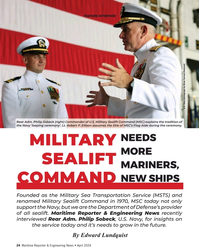 )
April 2024 - Maritime Reporter and Engineering News page: 24
)
April 2024 - Maritime Reporter and Engineering News page: 24FEATURE INTERVIEW U.S. Navy photograph by Brian Suriani/Released Rear Adm. Philip Sobeck (right) Commander of U.S. Military Sealift Command (MSC) explains the tradition of the Navy ‘looping ceremony’. Lt. Robert P. Ellison assumes the title of MSC’s Flag Aide during the ceremony. NEEDS MILITARY MORE
-
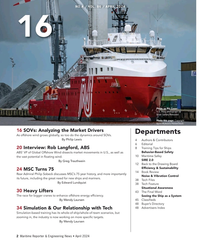 )
April 2024 - Maritime Reporter and Engineering News page: 2
)
April 2024 - Maritime Reporter and Engineering News page: 2NO.4 / VOL. 86 / APRIL 2024 16 Photo on the Cover: U.S. Navy photograph by Brian Suriani/Released Photo this page: Copyright Björn Wylezich/AdobeStock 16 SOVs: Analyzing the Market Drivers Departments As offshore wind grows globally, so too do the dynamics around SOVs. By Philip Lewis 4 Authors & Contribut
-
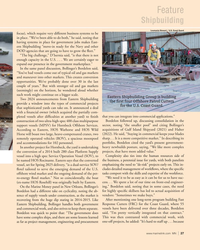 )
April 2024 - Marine News page: 27
)
April 2024 - Marine News page: 27Feature Shipbuilding Loumania Stewart / U.S. Coast Guard focus), which require very different business systems to be in place. “We’ve been able to do both,” he said, noting that having systems in place for government jobs makes East- ern Shipbuilding “move-in ready for the Navy and other DOD agencies
-
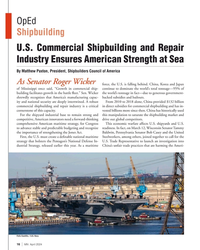 )
April 2024 - Marine News page: 16
)
April 2024 - Marine News page: 16OpEd Shipbuilding U.S. Commercial Shipbuilding and Repair Industry Ensures American Strength at Sea By Matthew Paxton, President, Shipbuilders Council of America As Senator Roger Wicker force, the U.S. is falling behind. China, Korea and Japan of Mississippi once said, “Growth in commercial ship-
-
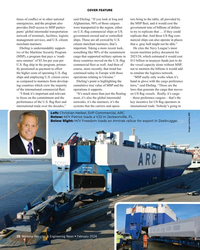 )
February 2024 - Maritime Reporter and Engineering News page: 28
)
February 2024 - Maritime Reporter and Engineering News page: 28COVER FEATURE times of con? ict or in other national said Ebeling. “If you look at Iraq and tors bring to the table, all provided by emergencies, and the program also Afghanistan, 98% of those cargoes the MSP ? eet, and it would cost the provides DoD access to MSP partici- were transported to the
-
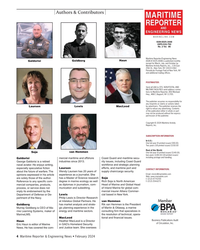 )
February 2024 - Maritime Reporter and Engineering News page: 4
)
February 2024 - Maritime Reporter and Engineering News page: 4Authors & Contributors MARITIME REPORTER AND ENGINEERING NEWS M A R I N E L I N K . C O M ISSN-0025-3448 USPS-016-750 No. 2 Vol. 86 Maritime Reporter/Engineering News Goldberg Haun (ISSN # 0025-3448) is published monthly Galdorisi except for March, July, and October by Maritime Activity Reports, Inc.
-
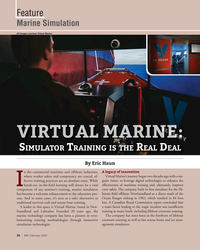 )
February 2024 - Marine News page: 34
)
February 2024 - Marine News page: 34as a safer alternative to Ocean Ranger sinking in 1982, which resulted in 84 lives traditional survival craft and rescue boat training. lost. A Canadian Royal Commission report concluded that A leader in this space is Virtual Marine, based in New- a main factor leading to the tragic incident was insuf?
-
 )
January 2024 - Marine Technology Reporter page: 60
)
January 2024 - Marine Technology Reporter page: 60brings together thought leaders from industry, academia and Dockside Demonstrations government to discuss meeting future ocean technology needs On the Royal Victoria Dock, the Dockside Demos feature in line with market developments and new ocean enterprise gives visitors the opportunity to experience
-
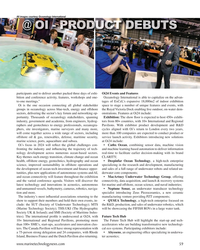 )
January 2024 - Marine Technology Reporter page: 59
)
January 2024 - Marine Technology Reporter page: 59all global stakeholder space to stage a number of unique features and events, with groups in oceanology across blue-tech, energy and offshore the Royal Victoria Dock enabling live outdoor, on-water dem- sectors, delivering the sector’s key forum and networking op- onstrations. Features at Oi24 include: port
-
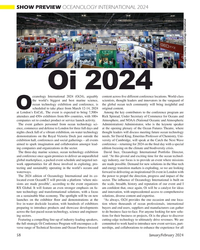 )
January 2024 - Marine Technology Reporter page: 58
)
January 2024 - Marine Technology Reporter page: 58, where nights chock full of a vibrant exhibition, on-water technology thought leaders will discuss meeting future ocean technology demonstrations on the Royal Victoria Dock just outside the needs. Sir David King, Emeritus Professor of Chemistry, Uni- exhibition hall, conferences and social gatherings – all
-
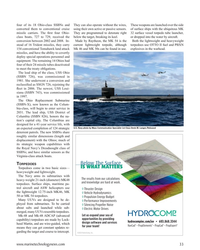 )
January 2024 - Marine Technology Reporter page: 33
)
January 2024 - Marine Technology Reporter page: 33patrols. The new SSBNs share roughly similar dimensions (length and displacement) with the Ohios; much of its strategic weapon capabilities with the Royal Navy’s Dreadnought class of SSBNs; and have similar sensors as the Virginia-class attack boats. Below The Surface TORPEDOES IS WHAT MATTERS Torpedoes
-
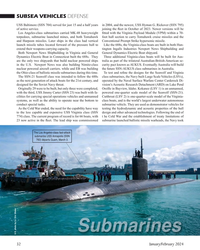 )
January 2024 - Marine Technology Reporter page: 32
)
January 2024 - Marine Technology Reporter page: 32SUBSEA VEHICLES DEFENSE USS Baltimore (SSN 704) served for just 15 and a half years in 2004, and the newest, USS Hyman G. Rickover (SSN 795) of active service. joining the ? eet in October of 2023. Newer versions will be Los Angeles-class submarines carried MK-48 heavyweight ? tted with the Virginia
-
 )
January 2024 - Marine Technology Reporter page: 31
)
January 2024 - Marine Technology Reporter page: 31at depths up to 1,000 feet. serve as a moored training ship (MTS ton. Some of the 688s were pulled from Hammerhead consists of a mooring 701) and the Nuclear Power School service at their mid-life point rather than module that plants itself on the bot- in Charleson, S.C. Likewise USS San incur the
-
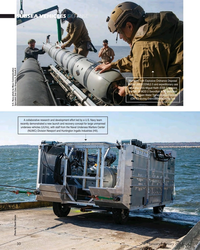 )
January 2024 - Marine Technology Reporter page: 30
)
January 2024 - Marine Technology Reporter page: 30SUBSEA VEHICLES DEFENSE Members from Explosive Ordnance Disposal Mobile Unit (EODMU) 5 and expeditionary sea base ship USS Miguel Keith (ESB 5) prepare the MK 18 MOD 2 Sword? sh to be deployed from the Open Water Transportation System (OWTS) during Exercise Noble Vanguard. U.S. Navy photo by Mass
-
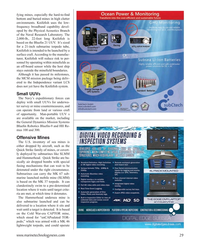 )
January 2024 - Marine Technology Reporter page: 29
)
January 2024 - Marine Technology Reporter page: 29fying mines, especially the hard-to-? nd bottom and buried mines in high clutter environments. Knife? sh uses the low- frequency broadband capability devel- oped by the Physical Acoustics Branch of the Naval Research Laboratory. The 2,000-lb., 22-foot long Knife? sh is based on the Blue? n 21 UUV.
-
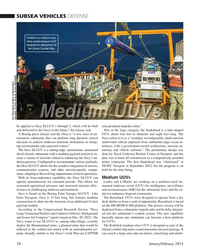 )
January 2024 - Marine Technology Reporter page: 28
)
January 2024 - Marine Technology Reporter page: 28SUBSEA VEHICLES DEFENSE Knife? sh is a medium-class mine countermeasure UUV designed for deployment off the Littoral Combat Ship. U.S. Navy photo by Mass Communication Specialist 1st Class Brian M. Brooks/RELEASED be applied to Orca XLUUV 1 through 5, which will be built (encapsulated torpedo) mine.
